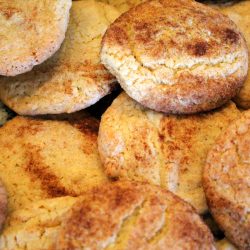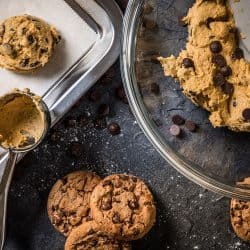Trying new recipes in your kitchen isn't always as easy as it seems. For example, did you recently bake a sheet of snickerdoodle cookies only to have them stay super puffy? Since snickerdoodles should be flat, why did this happen? Does it mean you went overboard with the wrong ingredient?
Well, we've done some digging and have the reason why this happens below!
The main reason a snickerdoodle stays so puffy is if you use too much flour. Generally, adding more flour than a recipe calls for can cause your cookies to bloat. Cookies rely on the perfect ratio of butter to flour to keep a regular shape, so remember that the next time you're making snickerdoodles.
As we start this article, we will cover all things baking snickerdoodles and discuss why yours stayed so puffy even after being in the oven. Whether you're an aspiring baker, love to make treats around the holidays, or have additional questions, we're here to assist. With that said, let's dive right in!
Why Are My Snickerdoodles So Puffy?
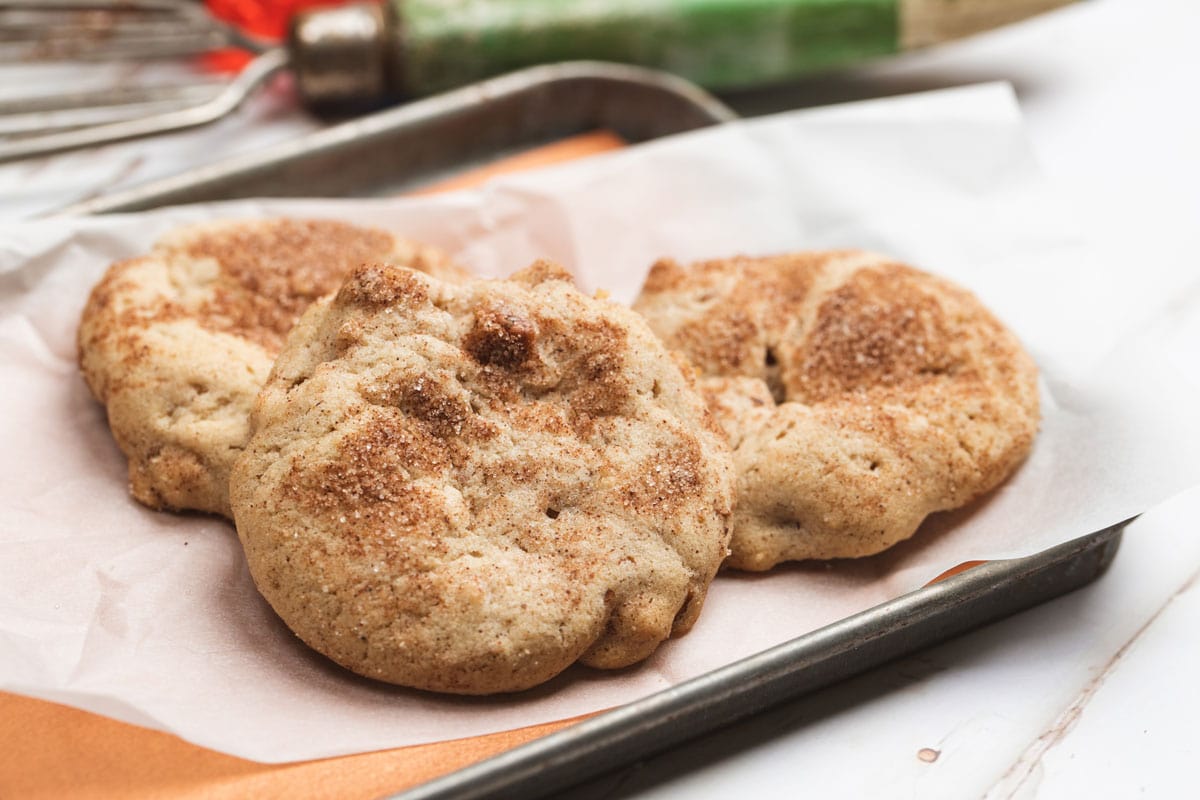
One of the main causes of puffy snickerdoodles is adding too much flour to your recipe. As we said, the butter-to-flour ratio must be almost perfect for ensuring your cookies keep their desired shape.
In addition, using too much flour in your snickerdoodles can also affect their flavor, so this isn't generally a good ingredient to alter. Instead, follow your recipe closely, adding just enough flour to your cookies.
On top of that, some chefs claim that using the wrong oven temperature can also cause snickerdoodles to rise and not go back down, so make sure to use the correct temperature as well.
Many people don't realize that making cookies can be intricate, with precise instructions you'll need to follow. Even the slightest adjustment to your recipe can cause your snickerdoodles to look and taste funny, so always remember to stick to the book.
How Much Flour Should You Add To Snickerdoodles?
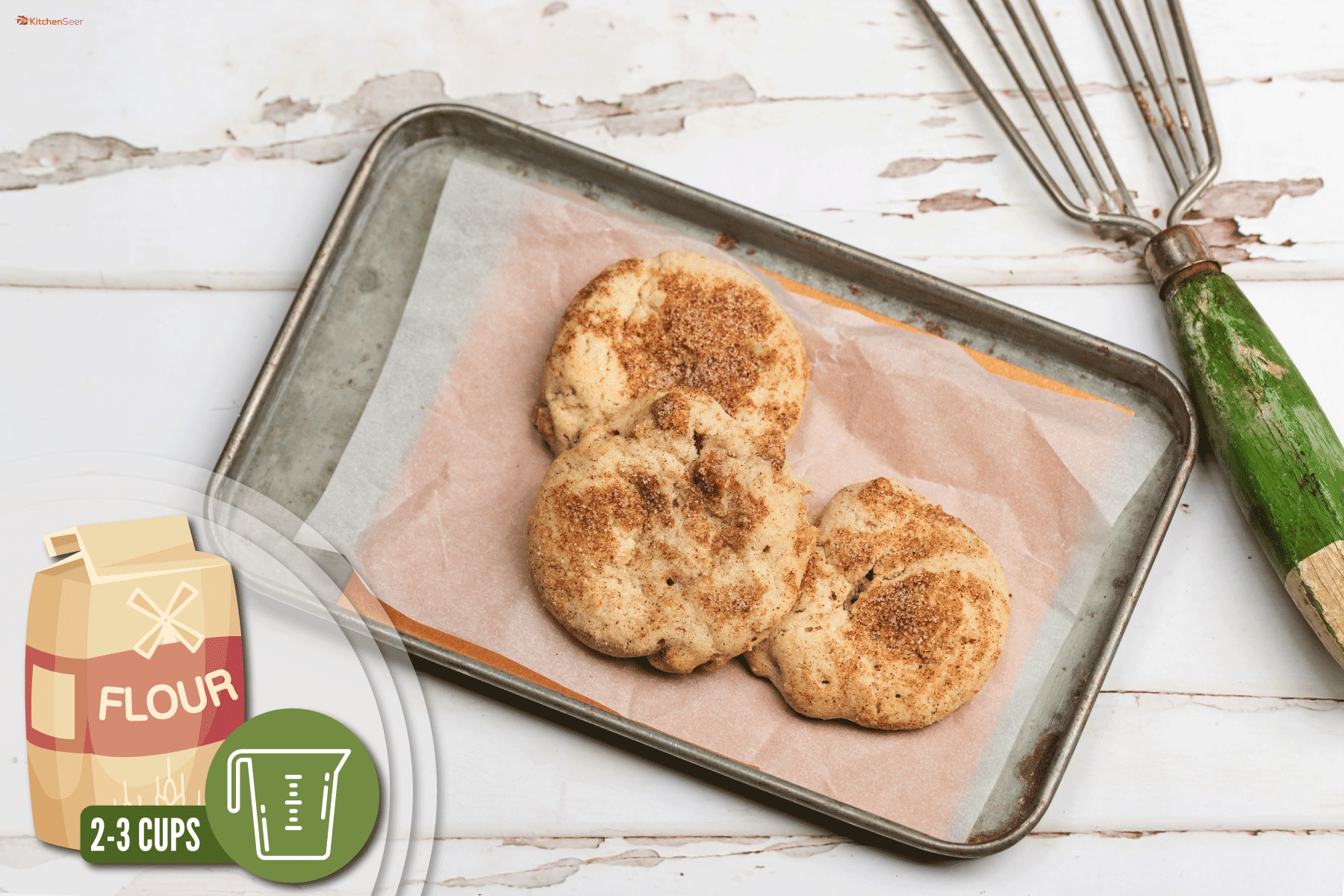
Although the amount of flour your mix into your snickerdoodles will vary on the batch size, many chefs recommend using around 2-3 cups.
For example, this snickerdoodle recipe calls for 2 3/4 cups (370g) of all-purpose flour, while this one wants you to put closer to 3 cups (375g) of all-purpose flour.
As we mentioned above, adding more flour than a recipe calls for will make your snickerdoodles puffy and lose a bit of their signature taste/texture.
Therefore, if a certain recipe you choose calls for closer to two cups, we don't recommend getting adventurous and going with three or more.
Additionally, your butter-to-flour ratio needs to be right. Butter adds weight to your cookies, counteracting the rising of the flour. So, if you add more flour, add more butter too.
What Do Puffy Snickerdoodles Taste Like?
If your snickerdoodles come out of the oven super puffy, this may affect their taste. For example, adding too much flour is the leading cause of overly puffy cookies, so you could taste hints of it in your final dessert.
On top of that, snickerdoodles with too much puff could be over or undercooked. Remember, if your oven isn't set to the proper temperature, your cookies may not cook all the way through.
Luckily, if you notice your snickerdoodles looking and tasting undone, you should be able to throw them back into the oven for another ten or so minutes.
With that said, your ingredients and their ratios are typically to blame.
If you add too much of a specific ingredient to your snickerdoodles, it's more likely to taste more prevalent when all the baking is finished. So, keep everything correct according to your recipe, and if your dessert looks/tastes unfinished: throw it back in the oven.
What Do Undercooked Snickerdoodles Taste Like?
Generally, undercooked snickerdoodles will taste a bit doughy or cakey. Since you need to bake snickerdoodles thoroughly, not having your dessert finish in the oven can make it taste off.
Moreover, you might be able to taste the raw mix of your snickerdoodle in this situation, which won't be yummy or technically safe to consume in high volumes.
You use eggs and other dairies to bake snickerdoodles, which should be cooked through. However, some bakers prefer when their snickerdoodles are crunchy around the ends and soft and chewy towards the middle: so this also depends on your preference.
Think of the last time you bought snickerdoodles from the store. Were they super gooey? Or were they harder toward the end and soft in the middle?
You can always test one cookie and see if it tastes raw before ending your baking cycle, which we recommend for whatever you prepare.
Should A Snickerdoodle Be Flat?
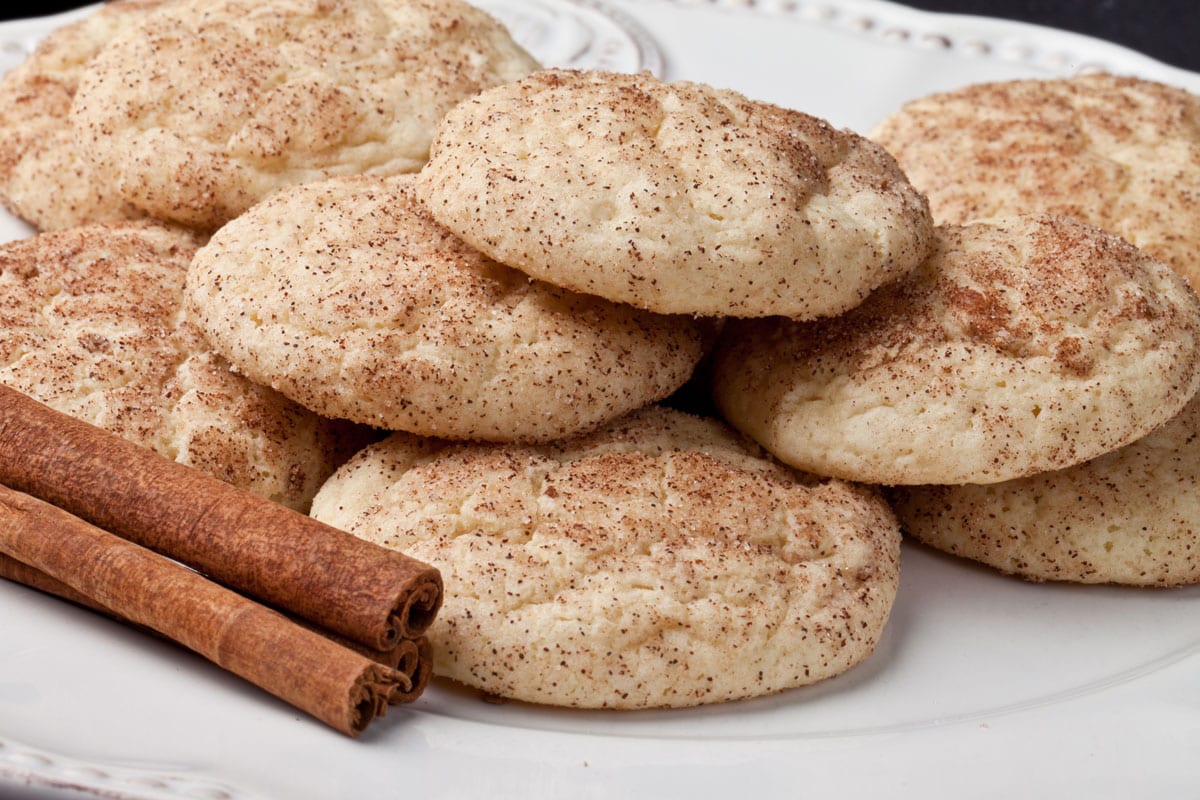
Although snickerdoodles shouldn't be flat, they don't need to be super puffy, either. As we said, adding an incorrect amount of flour to your recipe typically causes cookie bloating.
Therefore, not adding enough flour can also cause the reverse effect: an ultra-flat cookie. Again, following your given recipe is crucial for a perfect dessert.
Making even slight adjustments can set off the balance of your snickerdoodle. Again, you want your snickerdoodles slightly raised when they're done, but not so much that they look bloated.
Try and treat these like a regular cookie you bake. Generally, it's a good sign to notice some rising during baking. However, your snickerdoodles shouldn't be so puffy they feel like clouds when they're out of the oven.
Try and let them cool, see if their shape flattens a bit, and add less flour to the next batch if they stay bloated. Baking is a learning experience, so don't be afraid to make mistakes!
Pro Tip: your butter may also be too cold if your cookies don't flatten, so try and let it warm a bit before adding it to your snickerdoodle mix.
Check out our other post for more info on this: Why Are My Snickerdoodles Flat? [And How To Prevent This]
Why Did My Snickerdoodles Come Out Cakey?
Switching gears and textures, what causes snickerdoodles to come out tasting cakey? Well, you can usually blame dough with too much flour, overbeaten, or too much baking powder.
According to Into The Cookie Jar, your snickerdoodle may also have too many eggs if it looks and tastes cakey. When this happens, your snickerdoodles may taste raw or unfinished, indicating there is too much of a certain ingredient inside them.
Adding too much flour, adding too much baking powder, overbeating, or including more eggs than a recipe calls for can create a cakey texture.
Fixing this mistake can be challenging, especially if you have already baked your sweets. So, if you don't mind making another batch, you might want to start over for the sake of your cookies' quality.
Many chefs do a trial run of a new recipe, only using a small portion of their ingredients, so that's another idea for newer snickerdoodle makers. Test the waters and see what works for you.
Why Did My Snickerdoodles Come Out Hard?
Now, if you notice your snickerdoodles come out of the oven hard or dry, this is likely due to low temperatures. Most often, cooking snickerdoodles at too low of temperatures can cause the moisture inside them to evaporate faster.
An interesting fact about cookie making is that your dessert constantly loses moisture. Experts claim the moisture in cookies is in a constant state of evaporation as soon as they leave the oven.
However, that doesn't mean your snickerdoodles should be immediately dry and hard.
In addition, depending on your recipe, your cookies could be dry to start with. That lack of moisture will make them hard as they bake, leading to teeth-chipping cookies.
So, try and keep your snickerdoodle mix moist, and don't set the oven lower than recommended. Feeling Foodish recommends cranking the oven to 375 for cookies rather than 350 to prevent hardness.
Remember, nobody ever complained about a cookie being too warm and moist!
How Long Should Snickerdoodles Be In The Oven?
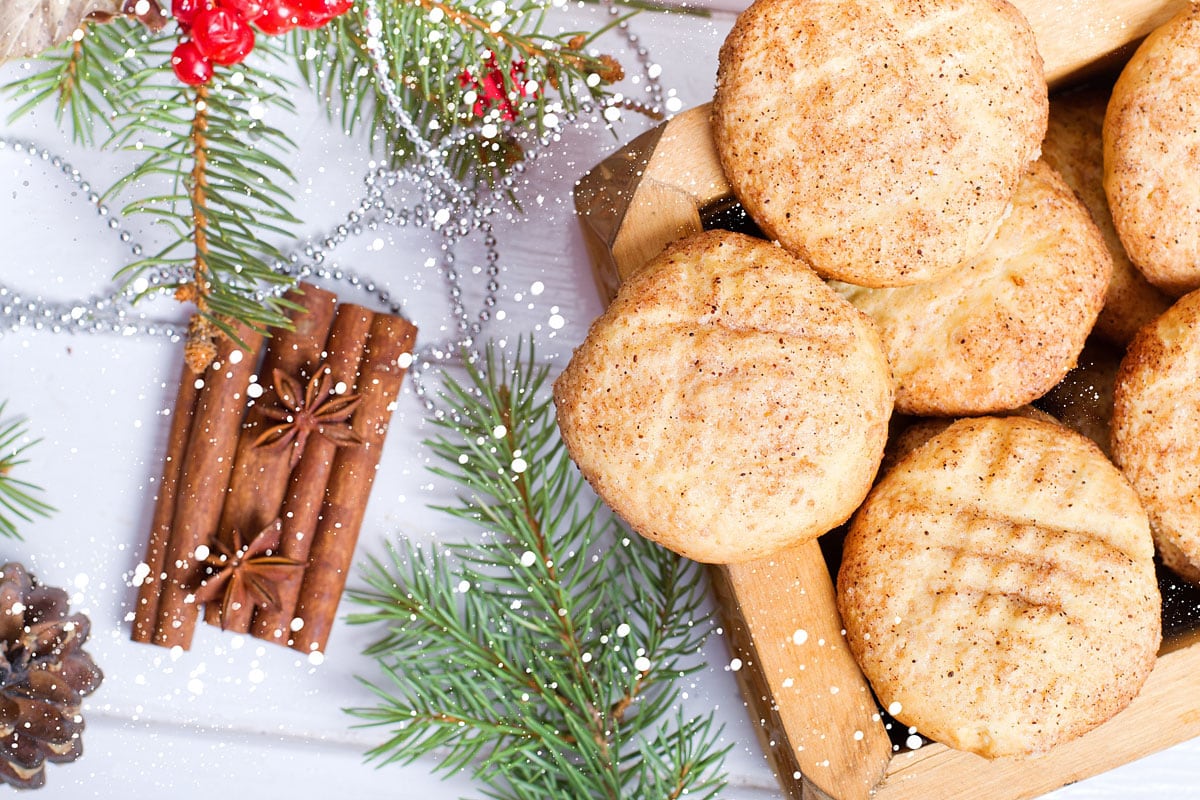
Although this can vary slightly, you shouldn't need to have snickerdoodles in the oven for more than ten minutes. Of course, assuming your temperature is around 350-375, snickerdoodles won't take long to bake.
As we mentioned above, overcooking snickerdoodles will cause hardness, dryness, or even a change in texture, so you don't want to get too zealous.
Generally, baking cookies shouldn't take more than 15-20 minutes in total, with about half that time being in the oven. With that said, depending on the batch size and method/ingredients, you could look at more oven or prep time.
Luckily, most recipes include an ETA for your timeline, so try and stick to that. You may also prefer less oven time for your snickerdoodles if you're worried about them drying out.
Some bakers prefer a soft, chewy inside and harder border on their snickerdoodles, so this depends on your preference and when you plan to serve your cookies.
As long as your dessert is cooked through and safe to eat, we see no problem shortening its bake time!
To Finish It Up
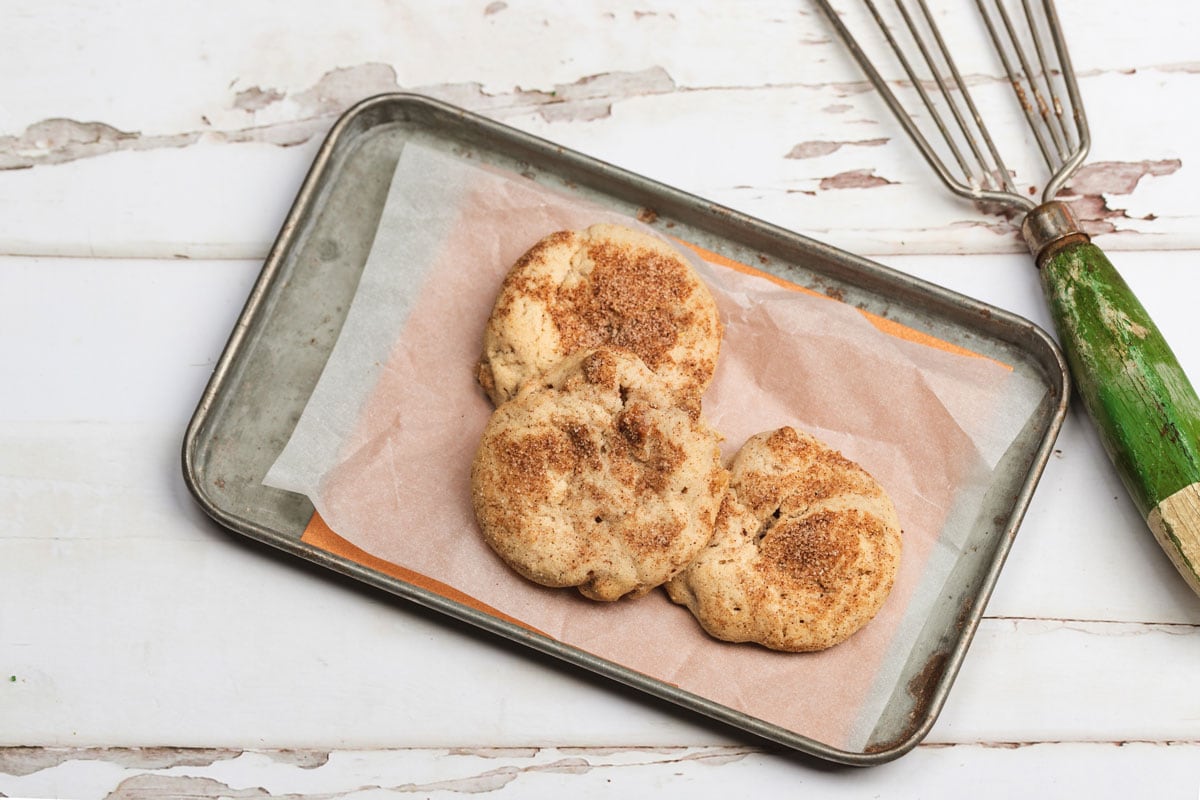
Whether you're new to making snickerdoodles or consider yourself a pro, it's always good to understand what causes a change in their texture. We found that snickerdoodles will become puffy if you add too much flour.
When you do this, the added flour will cause your cookie to rise, giving it a bloated appearance. One thing to remember when preparing snickerdoodles is that their butter-to-flour ratio needs to be close to ensure that puffiness doesn't happen.
Again, you don't want your snickerdoodles dry and flat, but you also don't want them cakey, puffy, or tasting like they are undercooked. Don't be afraid to make a test batch if you're unfamiliar with a new recipe!
And while we have your attention, check out these helpful related kitchen articles below:
Can You Freeze Snickerdoodle Dough?
Snickerdoodle Cookie Vs. Sugar Cookie
Should You Flatten Cookies Before Baking?

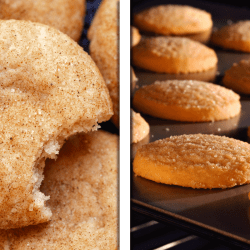
![Overhead view of homemade snickerdoodle cookies with a bite missing - Why Are My Snickerdoodles Flat [And How To Prevent This]](https://kitchenseer.com/wp-content/uploads/2022/04/Overhead-view-of-homemade-snickerdoodle-cookies-with-a-bite-missing-250x250.jpg)

